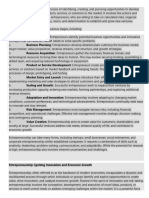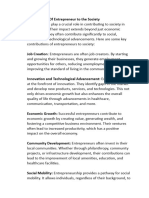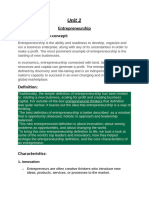startup unit 1
Uploaded by
preetikumari80320266startup unit 1
Uploaded by
preetikumari80320266UNIT 1
Introduction to Entrepreneurship and Startups
1.1 What is Entrepreneurship?
Entrepreneurship involves starting and managing a business to seek profit, solve
problems, or innovate.
Entrepreneurs identify opportunities, take risks, and organize resources to create
products/services.
Success is driven by vision, creativity, and perseverance.
Entrepreneurs aim for financial success, social impact, and problem-solving.
1.2 Understanding Startups
Startups are new businesses focused on innovation, scalability, and rapid growth.
Key Features of Startups:
o Innovation: Introducing new or improved products/services.
o Scalability: Potential to expand quickly into larger markets.
o Risk & Uncertainty: Face high risks, market challenges, and financial
instability.
1.3 Importance of Entrepreneurship & Startups
Economic Growth: Creates jobs and contributes to GDP.
Innovation & Technology: Drives advancements and industry disruptions.
Job Creation: Provides employment, particularly for skilled workers.
Problem-Solving: Addresses societal needs through products or services.
1.4 Entrepreneurial Characteristics
Risk Tolerance: Willingness to take calculated risks.
Creativity: Ability to develop unique solutions.
Persistence & Resilience: Overcoming failures and challenges.
Adaptability: Adjusting strategies based on market conditions.
Vision & Passion: A clear goal and motivation to achieve it.
Leadership: Ability to guide and inspire a team.
1.5 Types of Entrepreneurs
Innovative Entrepreneurs: Create new products/services with significant impact.
Imitative Entrepreneurs: Improve existing business ideas.
Scalable Startups: Focus on rapid expansion and growth.
Small Business Entrepreneurs: Local businesses providing stability and jobs.
Social Entrepreneurs: Aim to solve social or environmental issues.
1.6 The Startup Ecosystem
Entrepreneurs: Develop and execute business ideas.
Investors: Provide financial support (angel investors, venture capitalists).
Incubators & Accelerators: Offer mentorship and resources for growth.
Government Policies: Grants, tax benefits, and support programs.
Educational Institutions: Training, workshops, and networking opportunities.
Customers & Users: Provide feedback for improvement.
1.7 The Journey of Building a Startup
1. Idea Generation: Identifying a problem or market gap.
2. Market Research: Understanding customer needs and competition.
3. Business Model Development: Defining revenue generation strategies.
4. Prototype & MVP (Minimum Viable Product): Testing the product with early users.
5. Funding: Raising capital (self-funding, investors, crowdfunding).
6. Launch & Growth: Marketing, customer acquisition, and operational setup.
7. Scaling: Expanding business reach and resources.
8. Exit or Maturity: Selling the business, IPO, or continued management.
1.8 Challenges Faced by Entrepreneurs
Lack of Funding: Difficulty in securing capital.
Market Uncertainty: Fluctuating customer demands and competition.
Intense Competition: Standing out in a crowded market.
Legal & Regulatory Issues: Compliance with business laws and taxes.
Team Building: Finding skilled and motivated employees.
1.9 Conclusion
Entrepreneurship is a path of innovation, risk-taking, and problem-solving.
Despite challenges, it provides opportunities for economic growth, job creation,
and technological advancements.
Entrepreneurs, especially those with technical skills, can make a significant impact
on industries and society.
Definition of Entrepreneurship and Startups
Entrepreneurship
Definition:
o Process of creating, organizing, and managing a business to make a profit or
solve a problem.
o Entrepreneurs identify opportunities, take risks, and gather resources to
bring ideas to life.
o Converts ideas into reality through innovative products, services, or
solutions.
Key Elements of Entrepreneurship:
o Innovation: Developing new or improved products/services.
o Risk-taking: Willingness to take financial and strategic risks.
o Vision: Clear direction for business growth.
o Problem-solving: Identifying and addressing market needs.
Startups
Definition:
o A newly established business focusing on innovation, rapid growth, and
scalability.
o Aims to disrupt traditional industries with new business models or
technologies.
o Technology and capital play a key role in scaling.
Key Characteristics of Startups:
o Innovation & Disruption: Introducing new business ideas or models.
o Growth & Scalability: Expanding rapidly to a larger market.
o High Risk & Uncertainty: Success is not guaranteed, and challenges are
significant.
Why Entrepreneurship & Startups Matter
For Entrepreneurs: Opportunity to pursue passions, build businesses, and innovate.
For the Economy: Contribute to economic growth, job creation, and new
technologies.
For Society: Solve pressing issues, improve lives, and drive progress.
For Polytechnic Students:
o Apply technical skills to real-world problems.
o Create opportunities as business owners or startup team members.
Traits of an Entrepreneur
Successful entrepreneurs share specific traits that help them navigate challenges, innovate,
and grow their businesses.
1. Creativity and Innovation
Think outside the box to create new solutions, products, or services.
Stay ahead of competitors by identifying and solving problems uniquely.
Example: A student developing an app to improve group project communication.
2. Risk-taking and Courage
Willing to take financial and strategic risks to achieve success.
Step out of comfort zones despite uncertainty.
Example: Investing personal savings to start a business.
3. Resilience and Perseverance
Ability to bounce back from failures and setbacks.
Learn from mistakes and keep moving forward.
Example: Improving a failed startup idea and trying again.
4. Adaptability and Flexibility
Adjust to changing markets, customer needs, and technology trends.
Be open to pivoting business models based on new information.
Example: Switching from a physical store to an online platform.
5. Visionary Thinking
See the big picture and set long-term goals.
Recognize future trends and potential business opportunities.
Example: Foreseeing how automation can change an industry.
6. Decision-making and Problem-solving Skills
Ability to analyze situations and make quick, informed decisions.
Solve operational and strategic problems effectively.
Example: Finding an alternative supplier during a manufacturing delay.
7. Passion and Determination
Passion keeps entrepreneurs motivated through challenges.
Determination helps maintain focus on long-term objectives.
Example: Persisting in developing eco-friendly products despite challenges.
8. Leadership and Team-building Skills
Inspire and guide a team towards business success.
Delegate tasks and create a strong business culture.
Example: Recruiting and motivating classmates to develop a startup project.
9. Time Management and Organizational Skills
Handle multiple responsibilities efficiently.
Prioritize tasks to maintain productivity.
Example: Balancing studies, business management, and personal life.
10. Financial Literacy and Management
Understand budgeting, cash flow, and profit margins.
Make smart financial decisions to ensure business sustainability.
Example: Calculating product costs and setting a profitable price.
11. Networking and Communication Skills
Build relationships with customers, investors, and business partners.
Communicate ideas effectively to attract opportunities.
Example: Attending industry events to connect with mentors and investors.
12. Customer-Centric Mindset
Focus on understanding and meeting customer needs.
Improve products based on user feedback.
Example: Refining an app based on customer suggestions.
13. Self-Confidence and Self-Motivation
Believe in one’s abilities and ideas despite challenges.
Stay motivated even without external support.
Example: Working hard on a business idea despite lack of funding.
Conclusion
Many of these traits are developed through experience.
Polytechnic students already possess technical skills; combining them with these
traits increases entrepreneurial success.
Cultivating these traits helps launch a business or contribute to a growing startup.
Entrepreneurship
Introduction to Entrepreneurship
Process of identifying a business opportunity, taking risks, and organizing resources
to start and grow a business.
Entrepreneurs use creativity, innovation, and drive to bring ideas to life and solve
problems.
Polytechnic students can leverage technical skills to create innovative products or
services.
Why Entrepreneurship Matters
1. Economic Growth – Creates jobs, drives competition, and fosters innovation.
2. Job Creation – Reduces unemployment by generating employment opportunities.
3. Problem Solving – Addresses challenges in industries like engineering, healthcare,
and technology.
4. Innovation – Entrepreneurs disrupt traditional business models with new ideas.
Key Steps in the Entrepreneurship Journey
1. Idea Generation
Identify a problem in your community or industry.
Leverage your technical skills to create a solution.
2. Market Research
Identify Target Market – Understand customer demographics, needs, and behaviors.
Analyze Competitors – Study market leaders and gaps in their services.
Evaluate Demand – Conduct surveys or interviews to validate your idea.
3. Develop a Business Plan
Executive Summary – Overview of business goals and strategies.
Business Description – Define product/service and target audience.
Market Analysis – Competitor research and customer insights.
Revenue Model – Define how your business will generate income.
Marketing Strategy – Plan to attract and retain customers.
Financial Projections – Estimate costs, revenue, and profitability.
4. Funding Your Startup
Personal Savings – Self-funding from your own resources.
Family and Friends – Borrowing small investments.
Angel Investors/Venture Capital – Equity-based funding for high-growth startups.
Government Grants and Loans – Financial support for innovative businesses.
Crowdfunding – Raising money through platforms like Kickstarter.
5. Build Your Product or Service
Prototype – Develop a basic version of your product for testing.
Test and Refine – Collect customer feedback and make improvements.
Quality Control – Ensure the product meets industry standards.
6. Launch Your Business
Create an Online Presence – Build a website and use social media.
Marketing Strategy – Utilize digital and traditional marketing methods.
Customer Service – Maintain excellent service to retain customers.
7. Grow Your Business
Optimize Operations – Improve efficiency and reduce costs.
Hiring and Team Building – Expand workforce as needed.
Seek Partnerships – Collaborate with other businesses for growth.
Essential Skills for Entrepreneurs
1. Problem-Solving – Create innovative solutions.
2. Leadership – Guide and inspire teams.
3. Financial Management – Understand budgeting, pricing, and cash flow.
4. Sales and Marketing – Effectively promote products and close deals.
5. Communication – Clearly convey ideas to stakeholders.
6. Time Management – Balance studies and business efficiently.
7. Negotiation – Secure favorable deals with partners and investors.
Common Challenges in Entrepreneurship
Uncertainty – Market demand and business success are unpredictable.
Competition – Requires strategic positioning to stand out.
Funding – Securing capital is often challenging.
Time Commitment – Running a business requires dedication.
Balancing Studies and Business – Polytechnic students must manage both
responsibilities.
Conclusion: Why Consider Entrepreneurship?
Opportunity to create meaningful innovations and contribute to society.
Gain valuable business and problem-solving skills.
Challenges exist, but with determination, creativity, and learning, success is
achievable.
Motivation in Entrepreneurship
Introduction: Why Entrepreneurship?
Polytechnic students have technical skills that can be applied to create innovative
businesses.
Entrepreneurship allows individuals to build their own businesses, solve problems,
and create value.
Though it involves risks, it is a rewarding career path with long-term benefits.
1. The Power of Innovation and Problem-Solving
Entrepreneurs identify problems and develop solutions through products/services.
Polytechnic students can apply technical skills in real-world scenarios.
Motivational Insight: Entrepreneurship is about creating value and solving societal
issues, not just making money.
2. The Freedom to Pursue Your Passion
Entrepreneurs control their destiny and work on what they love.
No corporate restrictions—work aligns with personal values and vision.
Motivational Insight: Passion-driven work feels fulfilling and meaningful.
3. Financial Independence and Wealth Creation
Entrepreneurship offers the potential for financial rewards.
Self-sustained income source instead of relying on a job.
Motivational Insight: Building a business can lead to long-term financial freedom.
4. Personal Growth and Self-Development
Entrepreneurs develop leadership, time management, negotiation, and resilience.
Facing challenges leads to personal and professional growth.
Motivational Insight: Every obstacle strengthens skills and builds confidence.
5. Making a Difference and Creating Impact
Entrepreneurs solve real-world problems and drive positive change.
Business ideas can improve lives through social impact.
Motivational Insight: Entrepreneurship leaves a legacy and creates a lasting
difference.
6. Learning from Failure and Building Resilience
Failure is part of the journey but leads to learning and improvement.
Resilience and adaptability help overcome setbacks.
Motivational Insight: Successful entrepreneurs turn failures into stepping stones.
7. Building Your Own Business and Legacy
Opportunity to create something meaningful from scratch.
Work towards a vision that aligns with your passions.
Motivational Insight: Entrepreneurship allows you to shape your future and make
an impact.
Conclusion: Your Entrepreneurial Journey Starts Now
Entrepreneurship is challenging but rewarding.
Use your skills, passion, and resilience to start today.
Take the first step and learn as you go—the world is waiting for your ideas!
Types of Business Structures
Introduction: Understanding Business Structures
Choosing the right business structure impacts legal liability, taxation, funding, and
management.
Different structures offer varied levels of control, complexity, and financial
protection.
1. Sole Proprietorship
Single-owner business where the owner and business are legally the same entity.
Key Characteristics:
o Full control over business operations.
o Unlimited liability – Owner is personally responsible for debts.
o Pass-through taxation – Profits are reported on the owner's personal tax
return.
Advantages:
o Easy and inexpensive to set up.
o Full decision-making power.
o Simple tax filing.
Disadvantages:
o Personal liability for business debts.
o Limited ability to raise capital.
o Owner must manage everything alone.
Best For: Freelancers, consultants, small businesses with low risk.
2. Partnership
Two or more individuals share ownership and responsibilities.
Key Characteristics:
o General partnership – All partners share liability.
o Limited partnership (LP) – Some partners have reduced liability.
o Pass-through taxation – Profits are taxed on partners' personal returns.
Advantages:
o Shared responsibilities and expertise.
o Easier to raise capital than sole proprietorships.
o Simple to set up with fewer formalities.
Disadvantages:
o Unlimited liability for general partners.
o Potential conflicts among partners.
o Profit-sharing may cause disputes.
Best For: Joint ventures, startups with multiple founders, professional firms.
3. Limited Liability Company (LLC)
Combines the flexibility of partnerships with the liability protection of
corporations.
Key Characteristics:
o Owned by members (one or more individuals).
o Limited liability – Owners’ personal assets are protected.
o Can choose pass-through taxation or corporate taxation.
Advantages:
o Liability protection for owners.
o Flexible management structure.
o Tax flexibility.
Disadvantages:
o More expensive to set up than sole proprietorships or partnerships.
o Varies by state, with different regulations and fees.
o Owners may face self-employment taxes.
Best For: Small to medium-sized businesses, tech startups, service providers.
4. Corporation (C-Corp)
A separate legal entity from its owners (shareholders).
Key Characteristics:
o Owned by shareholders, managed by a board of directors.
o Limited liability – Shareholders are not personally responsible for debts.
o Double taxation – Corporate profits are taxed, and dividends are taxed again
at the shareholder level.
Advantages:
o Limited liability for shareholders.
o Easier to raise capital through stock sales.
o Business continues beyond the owner’s lifetime.
Disadvantages:
o Double taxation on profits and dividends.
o Complex setup with strict regulations.
o High administrative costs and legal requirements.
Best For: Large businesses, high-growth startups seeking investment.
5. S Corporation (S-Corp)
A special type of corporation that avoids double taxation.
Key Characteristics:
o Pass-through taxation – Profits and losses go directly to shareholders.
o Limited liability for owners.
o Restricted to 100 shareholders, all of whom must be U.S. citizens or
residents.
Advantages:
o Avoids double taxation (unlike C-Corps).
o Limited liability for owners.
o Potential tax savings on self-employment taxes.
Disadvantages:
o Strict eligibility rules.
o Limited to 100 shareholders.
o More administrative formalities than LLCs.
Best For: Small businesses that want liability protection and pass-through taxation.
Conclusion: Choosing the Right Structure
Sole Proprietorship – Best for simple, low-risk businesses.
Partnership – Good for businesses with multiple founders and shared
responsibilities.
LLC – Ideal for small to medium businesses needing liability protection and flexibility.
C-Corp – Best for businesses looking to scale and raise investment.
S-Corp – Suitable for small companies wanting tax benefits and limited liability.
Similarities and Differences Between
Entrepreneurs and Managers
Introduction: Understanding Entrepreneurs vs. Managers
Entrepreneurs and managers play crucial roles in business but have different
responsibilities.
Entrepreneurs focus on creating new businesses, while managers ensure efficient
operations.
Understanding their similarities and differences helps in deciding between starting a
business or managing one.
1. Who Are Entrepreneurs?
Definition: Entrepreneurs identify business opportunities, take risks, and create
new businesses.
Key Characteristics:
o Risk Takers – Willing to invest time, money, and effort into new ventures.
o Visionaries – Focus on innovation and long-term growth.
o Opportunity Seekers – Identify and capitalize on market gaps.
o Creative Thinkers – Develop unique ideas, products, or services.
Main Roles:
o Business Creation – Starting a new company based on an opportunity.
o Resource Acquisition – Securing capital, talent, and infrastructure.
o Innovation & Risk Management – Introducing new solutions while handling
uncertainty.
2. Who Are Managers?
Definition: Managers oversee daily operations, implement strategies, and ensure
efficiency.
Key Characteristics:
o Organized – Maintain order and control within a business.
o Problem Solvers – Handle day-to-day operational issues.
o Process-Oriented – Optimize workflows and ensure efficiency.
o Decision Makers – Make strategic and operational choices.
Main Roles:
o Execution – Implement business plans and strategies.
o Team Leadership – Manage and motivate employees.
o Operational Control – Oversee budgeting, scheduling, and reporting.
3. Similarities Between Entrepreneurs and Managers
Leadership Skills – Both need to inspire teams and maintain business focus.
Problem-Solving – Entrepreneurs solve startup challenges; managers solve
operational issues.
Decision-Making – Entrepreneurs decide on business creation, managers decide on
business operations.
Strategic Thinking – Entrepreneurs plan for growth, managers optimize execution.
Risk Management – Entrepreneurs handle business risks, managers manage
operational risks.
Shared Responsibilities:
o Setting and achieving business goals.
o Managing financial, human, and physical resources.
o Effective communication with employees, clients, and stakeholders.
4. Differences Between Entrepreneurs and Managers
Aspect Entrepreneurs Managers
Innovation, growth, and new
Focus Stability, efficiency, and operations.
opportunities.
High risk (financial, operational,Lower risk, focuses on minimizing
Risk-Taking
and personal). risks.
Works in uncertainty, pioneers Works in structure, follows
Approach
new ideas. established procedures.
Role in Business Creates new businesses, explores Handles existing businesses,
Lifecycle markets. optimizes processes.
Implementers – ensure smooth
Vision vs. Execution Visionaries – plan the future.
operations.
Focus on cost control and steady
Growth vs. Control Focus on expansion and scaling.
performance.
Implements strategies and improves
Innovation Develops new ideas and products.
efficiency.
Examples of Differences:
o Risk: An entrepreneur invests in developing a new mobile app; a manager
oversees the app’s development and marketing.
o Approach to Change: Entrepreneurs embrace uncertainty, while managers
prefer stability.
o Creativity vs. Efficiency: Entrepreneurs focus on new ideas, while managers
streamline existing ones.
5. Conclusion: Complementary Roles
Entrepreneurs create businesses, while managers sustain and grow them.
Both lead, solve problems, and make decisions, but with different goals.
Polytechnic students can choose entrepreneurship (starting a business) or
management (running one).
Understanding both roles helps in effectively working in a startup or corporate
environment
You might also like
- Entr 20063 Programs and Policies On Enterprise Development100% (1)Entr 20063 Programs and Policies On Enterprise Development134 pages
- Course Title entrepreneurship full notes--WPS OfficeNo ratings yetCourse Title entrepreneurship full notes--WPS Office44 pages
- Handouts 4_Summary of Entrep Overview + Spotting Business OpportunityNo ratings yetHandouts 4_Summary of Entrep Overview + Spotting Business Opportunity4 pages
- Unit-1 Entrepreneurship Introduction and Process100% (1)Unit-1 Entrepreneurship Introduction and Process12 pages
- 11th-Part-A (U4) Entrepreneurial Skills-IIINo ratings yet11th-Part-A (U4) Entrepreneurial Skills-III5 pages
- Enterpreneurship and Small Business DevelopmentNo ratings yetEnterpreneurship and Small Business Development17 pages
- Contribution of Entrepreneur To The SocietyNo ratings yetContribution of Entrepreneur To The Society94 pages
- Unit 2_Entrepreneurial Idea and InnovationNo ratings yetUnit 2_Entrepreneurial Idea and Innovation10 pages
- Enterprising_and_Innovation_Study_GuideNo ratings yetEnterprising_and_Innovation_Study_Guide14 pages
- Unit 1 Introduction to Entreprenuership and innovation[1]No ratings yetUnit 1 Introduction to Entreprenuership and innovation[1]14 pages
- The Entrepreneurship 2024: How to adopt mindset for EntrepreneurshipFrom EverandThe Entrepreneurship 2024: How to adopt mindset for EntrepreneurshipNo ratings yet
- Solid-Waste-Management-Towards-a-Sustainable-FutureNo ratings yetSolid-Waste-Management-Towards-a-Sustainable-Future10 pages
- Waste-Treatment-Technologies-An-OverviewNo ratings yetWaste-Treatment-Technologies-An-Overview3 pages
- Estimation and Costing Textbook by BN DuttaNo ratings yetEstimation and Costing Textbook by BN Dutta156 pages
- Management Information Systems Research For Small and Medium Enterprises: A Sustainability PerspectiveNo ratings yetManagement Information Systems Research For Small and Medium Enterprises: A Sustainability Perspective8 pages
- Determinants of Financial Literacy of Micro Entrepreneurs in Davao City IJAR 1 104No ratings yetDeterminants of Financial Literacy of Micro Entrepreneurs in Davao City IJAR 1 1048 pages
- Hand' Made in India: Tribal Sustainopreneurs of Change and ProsperityNo ratings yetHand' Made in India: Tribal Sustainopreneurs of Change and Prosperity15 pages
- Unit 4 - Institutional Support To Small and Medium EnterprisesNo ratings yetUnit 4 - Institutional Support To Small and Medium Enterprises24 pages
- Advertising---Creative-and-Digital-Strategy_Centennial-CollegeNo ratings yetAdvertising---Creative-and-Digital-Strategy_Centennial-College7 pages
- omran-yousafzai-2023-epistemic-injustice-and-epistemic-resistance-an-intersectional-study-of-women-s-entrepreneurshipNo ratings yetomran-yousafzai-2023-epistemic-injustice-and-epistemic-resistance-an-intersectional-study-of-women-s-entrepreneurship28 pages
- Upsc Mains Questions Management Optional Paper 1 Topicwise PDFNo ratings yetUpsc Mains Questions Management Optional Paper 1 Topicwise PDF20 pages
- The Importance of Innovation in EntrepreneurshipNo ratings yetThe Importance of Innovation in Entrepreneurship13 pages
- Unit 5 Emerging Trends in EntreprenerushipNo ratings yetUnit 5 Emerging Trends in Entrepreneruship16 pages
- Factors Affecting The Women Entrepreneurship Development in BangladeshNo ratings yetFactors Affecting The Women Entrepreneurship Development in Bangladesh7 pages
- Entr 20063 Programs and Policies On Enterprise DevelopmentEntr 20063 Programs and Policies On Enterprise Development
- Course Title entrepreneurship full notes--WPS OfficeCourse Title entrepreneurship full notes--WPS Office
- Handouts 4_Summary of Entrep Overview + Spotting Business OpportunityHandouts 4_Summary of Entrep Overview + Spotting Business Opportunity
- Unit 1 Introduction to Entreprenuership and innovation[1]Unit 1 Introduction to Entreprenuership and innovation[1]
- The Entrepreneurship 2024: How to adopt mindset for EntrepreneurshipFrom EverandThe Entrepreneurship 2024: How to adopt mindset for Entrepreneurship
- Solid-Waste-Management-Towards-a-Sustainable-FutureSolid-Waste-Management-Towards-a-Sustainable-Future
- Management Information Systems Research For Small and Medium Enterprises: A Sustainability PerspectiveManagement Information Systems Research For Small and Medium Enterprises: A Sustainability Perspective
- Determinants of Financial Literacy of Micro Entrepreneurs in Davao City IJAR 1 104Determinants of Financial Literacy of Micro Entrepreneurs in Davao City IJAR 1 104
- Hand' Made in India: Tribal Sustainopreneurs of Change and ProsperityHand' Made in India: Tribal Sustainopreneurs of Change and Prosperity
- Unit 4 - Institutional Support To Small and Medium EnterprisesUnit 4 - Institutional Support To Small and Medium Enterprises
- Advertising---Creative-and-Digital-Strategy_Centennial-CollegeAdvertising---Creative-and-Digital-Strategy_Centennial-College
- omran-yousafzai-2023-epistemic-injustice-and-epistemic-resistance-an-intersectional-study-of-women-s-entrepreneurshipomran-yousafzai-2023-epistemic-injustice-and-epistemic-resistance-an-intersectional-study-of-women-s-entrepreneurship
- Upsc Mains Questions Management Optional Paper 1 Topicwise PDFUpsc Mains Questions Management Optional Paper 1 Topicwise PDF
- Factors Affecting The Women Entrepreneurship Development in BangladeshFactors Affecting The Women Entrepreneurship Development in Bangladesh































































































